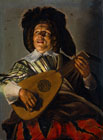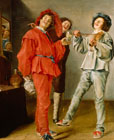I don’t belong to Facebook, and therefore can’t see what Jerry Saltz has been writing about the paucity of women artists at the Museum of Modern Art. I may not even have known about his seething criticism of MoMA’s “gender-based apartheid” had it not been for this entry on Doug McLennan’s Diacritical blog last week.
 But back in early May, when I first heard about MoMA’s “Modern Women’s Project,” presumably designed to redress the problem, I thought it was — frankly — stupid. According to published reports, MoMA’s project involves a series of exhibitions showing work by female artists and a book called “Women Artists in the Collection of the Museum of Modern Art.” So the way MoMA shows that it is an equal-opportunity exhibitor/collector is to create a ghetto for women artists?
But back in early May, when I first heard about MoMA’s “Modern Women’s Project,” presumably designed to redress the problem, I thought it was — frankly — stupid. According to published reports, MoMA’s project involves a series of exhibitions showing work by female artists and a book called “Women Artists in the Collection of the Museum of Modern Art.” So the way MoMA shows that it is an equal-opportunity exhibitor/collector is to create a ghetto for women artists?
That’s certainly not the way I would approach the problem. Morgan Freeman’s famous remark calling the idea of a month dedicated to black history “ridiculous” came immediately to my mind: “I don’t want a black history month. Black history is American history,” he said.
And I don’t want “women artists’ shows” — if curators can’t find women, in this day and age, whose art measures up to, or exceeds, work being created by men, they’re not doing their jobs.
Nor do I want shows that herald an artist who happens to be female as a woman artist — as if that in itself were a valorous and courageous thing to do.
So I was pleasantly surprised the other day when I received notice of the National Gallery of Art’s Judith Leyster, 1609 – 1660, which opens on June 21 and runs through Nov. 29. That’s her Self-Portrait, c. 1630, above.
In the press release and most of the online exhibition materials — not a mention of Leyster
 being a woman, not a whit of “aren’t we
being a woman, not a whit of “aren’t we
enlightened” for doing the show.
One relevant passage in her biography simply states:
In the years following her return to Haarlem, Judith Leyster achieved a degree of professional success that was quite remarkable for a female artist of her time. By 1633 she was a member of the Haarlem Guild of Saint Luke, the first woman admitted for which an oeuvre can be cited, and in 1635 she is recorded as having three students. One of these, Willem Wouters, subsequently defected to the studio of Hals, presumably without adequate warning, as Leyster went before the Guild of Saint Luke in October 1635 to make a (successful) demand for payment from Wouters’ mother.
The exhibition, a straightforward marking of Leyster’s 400th birthday —
 just the way we are celebrating Francis Bacon’s 100th birthday — is a small show involving about 10 of her works, including Serenade, 1629, above right, Merry Company, 1630-31, at left, and Concert, 1632-33, below right. It will also include a few works by Frans Hals, with whom she may have studied, and a painter named Jan Miense Molenaer (1610-1668), who was her husband.
just the way we are celebrating Francis Bacon’s 100th birthday — is a small show involving about 10 of her works, including Serenade, 1629, above right, Merry Company, 1630-31, at left, and Concert, 1632-33, below right. It will also include a few works by Frans Hals, with whom she may have studied, and a painter named Jan Miense Molenaer (1610-1668), who was her husband.
It’s Arthur Wheelock, Jr., the NGA’s curator of northern baroque painting and Vermeer expert, who deserves credit for refreshingly giving Leyster a show without all the claptrap overlay of her being a woman. He spreads the kudos to Frima Fox
 Hofrichter, a professor at Pratt Institute who wrote her dissertation on Leyster.
Hofrichter, a professor at Pratt Institute who wrote her dissertation on Leyster.
Wheelock says he chose the many of the show’s works with a music theme in mind, since it’s a celebration — and since Leyster had a larger show in Worcester and Haarlam, Holland, in 1993. Still, after it closes at the NGA, part of this show will go to the Frans Halsmuseum in Haarlam, Leyster’s home town.
There’s a lesson here for other museums.
Photo Credits (top to bottom): National Gallery of Art; Rijksmuseum, Amsterdam; Private Collection; National Gallery of Women in the Arts; all Courtesy National Gallery
